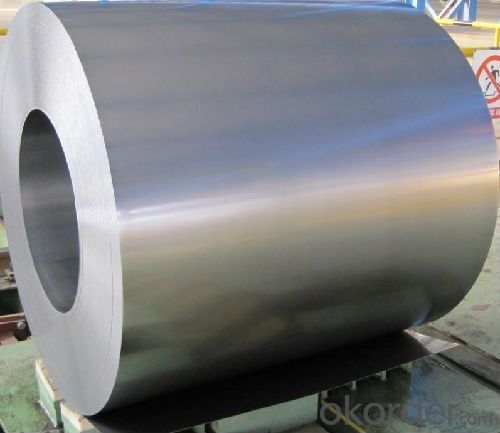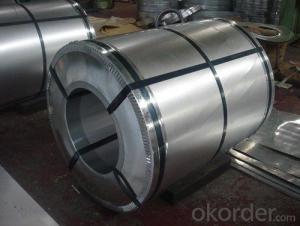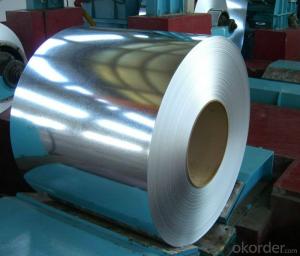Galvalume Hot Dip Galvanized Steel Sheet in Coils
- Loading Port:
- China main port
- Payment Terms:
- TT OR LC
- Min Order Qty:
- 50 m.t.
- Supply Capability:
- 10000 m.t./month
OKorder Service Pledge
OKorder Financial Service
You Might Also Like
Galvalume Steel Sheet in Coils with Prime Quality and Best Price
Product Description:
Structure:
Hot-dip galvanized steel coils are available with a pure zinc coating through the hot-dip galvanizing process. It offers the economy, strength and formability of steel combined with the corrosion resistance of zinc. The hot-dip process is the process by which steel gets coated in layers of zinc to protect against rust. It is especially useful for countless outdoor and industrial applications. Production of cold formed corrugated sheets and profiles for roofing, cladding, decking, tiles, sandwich walls, rainwater protective systems, air conditioning duct
Main Features:
• Excellent process capability
• Smooth and flat surface
• Workability, durability
• Excellent anticorrosive property
• High strength
• Good formability
• Good visual effect
Specification:
Standard: ASTM, JIS,EN
Grade: CS, DX51D+Z,SGCC, SS 230~550,S220GD+Z~S550GD+Z, SGC340~SGC570
Thickness: 0.1mm~5mm
Width: max 2000mm
Coil weight:3-12 MT
Coil ID:508/610mm
Surface structure: zero spangle, regular spangle or minimum spangle
Surface treatment: Chromate treatment, Oiled/dry, skinpassed/non-skinpassed
Packing: Standard seaworthy export package
Technology test results:
Processability | Yield strength | Tensile strength | Elongation % | 180°cold-bending |
Common PV | - | 270-500 | - | d=0,intact,no zinc removal |
Mechanical interlocking JY | - | 270-500 | - | d=0,intact,no zinc removal |
Structure JG | >=240 | >=370 | >=18 | d=0,intact,no zinc removal |
Deep drawn SC | - | 270-380 | >=30 | d=0,intact,no zinc removal |
EDDQ SC | - | 270-380 | >=30 | d=0,intact,no zinc removal |

- Q:How are steel coils cut to size?
- Steel coils are cut to size using a variety of methods such as shearing, slitting, or laser cutting. These processes involve using specialized machinery to ensure precise and accurate cuts according to the required dimensions.
- Q:How are steel coils used in the manufacturing of crash structures?
- Steel coils are used in the manufacturing of crash structures as they provide strength, durability, and energy absorption capabilities. These coils are typically formed into various shapes and sizes to create components that reinforce the vehicle's body, such as side impact beams or front and rear crumple zones. The steel coils absorb and distribute the impact energy during a crash, helping to protect the occupants by minimizing the force transferred to the passenger compartment.
- Q:What are the common methods of testing the strength of steel coils?
- Steel coils can be tested for strength using various methods. Tensile testing is one such method, which involves applying tension to the coil until it breaks. This test provides information about the coil's ability to withstand force and its tensile strength. It also reveals details about its yield strength and elongation properties. Another common method is hardness testing, which determines the steel's resistance to indentation or scratching. Different techniques like Rockwell, Brinell, or Vickers tests are utilized to measure hardness. This test helps determine the steel's ability to resist wear or deformation. To evaluate the coil's ductility and flexibility, bend testing is performed. The coil is bent to a specific angle and checked for any signs of cracking or fracturing. Bend testing assesses the material's capacity to withstand bending or forming procedures without failure. Additional methods of testing include impact testing, where controlled impacts are applied to assess the coil's resistance to sudden loading conditions, and fatigue testing, which involves subjecting the coil to cyclic loading to determine its endurance limit and potential for failure under repeated stress. It is important to note that the specific testing methods used may vary depending on the intended application and industry standards. Non-destructive testing techniques, such as ultrasonic testing or magnetic particle inspection, can also be employed to detect internal defects or flaws in steel coils without causing any damage.
- Q:How are steel coils loaded onto trucks or containers?
- Steel coils are typically loaded onto trucks or containers using specialized equipment such as cranes, forklifts, or coil trailers. The coils are lifted and secured onto the truck or container using straps, chains, or clamps to ensure safe transportation.
- Q:What are the dimensions of steel coils used in the metalworking tool industry?
- The dimensions of steel coils used in the metalworking tool industry vary depending on the specific requirements of the tool being manufactured. However, common dimensions for steel coils in this industry range from 0.5 to 3 millimeters in thickness and 1000 to 2000 millimeters in width.
- Q:i'm looking into buying a stainless steel ring for somebody as a gift.i'm on a budget (heh) and the ring is about $50.will it rust or tarnish? it'd be embarrassing if i gave it to someone, and it begins rusting :Pthanks
- Stainless Steel does not rust...that is why it is used in our kitchens and the top kitchens of the world...!! sorry...Stainless Steel does not Tarnish either!
- Q:How are steel coils processed?
- Steel coils are processed through a series of steps including pickling, cold rolling, annealing, and coating to achieve desired thickness, strength, and surface finish, making them ready for various applications in industries like automotive, construction, and manufacturing.
- Q:What are the factors affecting the formability of steel coils?
- There are several factors that can affect the formability of steel coils. Some of the key factors include the composition of the steel, its mechanical properties, the thickness and width of the coils, the temperature at which the forming process takes place, the type and amount of lubrication used, and the speed and pressure applied during forming. Additionally, the presence of defects or impurities in the steel can also impact its formability.
- Q:How are steel coils inspected for defects?
- Steel coils are inspected for defects through visual inspection, non-destructive testing methods such as ultrasonic testing or magnetic particle inspection, and dimensional measurements. These inspections help identify any surface defects, cracks, or irregularities in the steel coils.
- Q:How are steel coils used in the production of telecommunications equipment?
- The production of telecommunications equipment commonly involves the use of steel coils, which offer structural support and durability. These coils are utilized to fabricate different components, including cabinets, racks, and enclosures. A significant application of steel coils in telecommunications equipment is seen in the manufacturing of cabinets. These cabinets serve as housing for the delicate electronic components and wiring utilized in telecommunications systems. Steel coils are typically shaped to form the cabinet structure, providing a robust and dependable enclosure for the equipment. The steel material also offers protection against external factors such as impacts, dust, and moisture, ensuring the longevity and integrity of the telecommunications equipment. Steel coils also find application in the production of racks for telecommunications equipment. These racks are designed to organize and provide accessibility to multiple devices, including servers, switches, and routers. The strength and rigidity of steel coils make them an ideal material for constructing these racks, ensuring they can bear the weight of multiple devices and withstand the constant handling and movement that occur in telecommunication environments. Moreover, steel coils are used to manufacture enclosures for telecommunications equipment. These enclosures act as protective casings, safeguarding sensitive electronic components from external influences such as electromagnetic interference and physical damage. Steel coils are often formed into specific shapes and sizes to create these enclosures, providing a sturdy barrier that shields the equipment from various external threats. In conclusion, steel coils play a crucial role in the production of telecommunications equipment by offering structural support, durability, and protection. They are employed in the creation of cabinets, racks, and enclosures, which ensure the proper functioning and longevity of the sensitive electronic components used in telecommunication systems.
1. Manufacturer Overview |
|
|---|---|
| Location | |
| Year Established | |
| Annual Output Value | |
| Main Markets | |
| Company Certifications | |
2. Manufacturer Certificates |
|
|---|---|
| a) Certification Name | |
| Range | |
| Reference | |
| Validity Period | |
3. Manufacturer Capability |
|
|---|---|
| a)Trade Capacity | |
| Nearest Port | |
| Export Percentage | |
| No.of Employees in Trade Department | |
| Language Spoken: | |
| b)Factory Information | |
| Factory Size: | |
| No. of Production Lines | |
| Contract Manufacturing | |
| Product Price Range | |
Send your message to us
Galvalume Hot Dip Galvanized Steel Sheet in Coils
- Loading Port:
- China main port
- Payment Terms:
- TT OR LC
- Min Order Qty:
- 50 m.t.
- Supply Capability:
- 10000 m.t./month
OKorder Service Pledge
OKorder Financial Service
Similar products
New products
Hot products
Related keywords




























